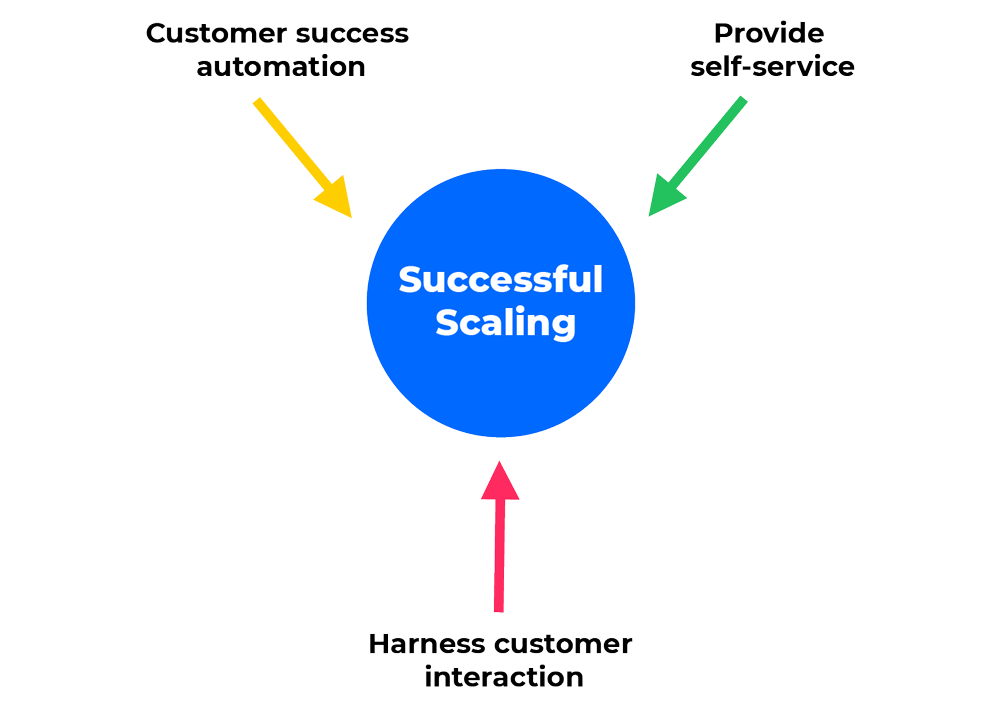Over the past year we’ve talked to over 30 Customer Success Management (CSM) leaders in the B2B SaaS space. It has been eye-opening to talk to such a wealth of industry knowledge. We’ve gained firsthand insights into the most pressing pain points in Customer Success (CS), pinpointed the differences in Customer Success strategies and pondered the future landscape of this rapidly-evolving industry.
While the issues Customer Success teams in B2B software companies face vary depending on a number of factors, we found that they all have one challenge in common: how to scale successfully. Or, as the head of Customer Success, Saahil Karkera, from the hotel-upselling tool, Oaky, neatly put it, “How do we keep a lean team, massively increase user volume and drive maximum customer ROI while keeping it personal?”
Before tackling that critical Customer Success challenge, let’s first look at three interesting patterns we discovered from our conversations with the industry leaders:
1. The structure of Customer Success teams differs greatly
Understandably, the way CS teams are organised tends to vary from company to company depending on their roles and responsibilities within the organisation. These range from very broad, with CS covering client success, operations, logistics and solutions, to a much more fixed remit where CS is focused solely on onboarding and product adoption. In some cases, CS even have a small customer marketing team who control existing customer communications.
Often in B2B Customer Success teams, the department is only focused on renewal of existing customer accounts, rather than upselling— which sits with the sales team. An interesting point to keep in mind is that not all CS teams have customer support within their department.
Last but not least, CS teams assign their accounts in different ways too. Here are a few examples of how customers are divvied up:
- Tiering system: Accounts are tiered based on ARR and divided among CSMs according to a capacity model that figures out how many accounts a CSM can cover based on frequency of touch points
- By geography: Accounts are assigned simply by geographical location
- Seniority of CSM: The most experienced Customer Success Managers or Directors get the key accounts, while the Associates get the lower end (longtail) accounts
2. That said, Customer Success objectives and KPIs are similar across organizations
On the whole—despite the structural differences between CS teams—overall goals are aligned. The three main KPIs are renewal rates (usually ranging from a target of 80-95%), expansion from cross sell (generally between 10 and 40%) and, of course, churn reduction. A few of the companies that we talked to had 20% churn rates, but a net revenue objective of 115%, meaning that 35% up/cross-sell needs to be generated from 80% of the customers. In other words, ARR per customer needs to increase, on average, by 44%—no mean feat.
3. Challenges are determined by the organization’s maturity stage
When companies grow at a fast pace, the issues they face change or evolve. We’ve all been there—just when you think one problem has been solved, another rears its head, and the same is true for challenges in Customer Success departments. In general we found that early stage CS teams were trying to overcome the following hurdles.
Early stage challenges:
- A lack of data: Customer data, internal process data, financial data, CRM data… the list of reporting metrics that can help improve the CS department is seemingly endless, and it can be difficult to get your hands on, never mind analyze.
- How to have impactful customer interactions: We found that while many CS departments hosted meetings with customers, effectively engaging with users and—most importantly—gaining product feedback is something many CS departments struggle with.
- Figuring out the most effective communication channels: Chat, email, live-video, phone, social media platforms, online communities? Assessing what communication channels work best for your company and how to use them to effectively help your customer base is a common headache for CSMs.
Then, as growth takes over, while these challenges may remain, they tend to be overshadowed by new obstacles:
- Attracting top CSM talent: Need we say more? According to this Gainsight report the CS industry is growing by an incredible 736%, so it’s easy to see why hunting out the best CSMs in the business is a tricky task.
- Delivering on promises: Sounds simple, but making sure CS teams live up to the promises made during the sales cycle is easier said than done.
- Motivation: This is as important for your own team as it is for your customers. Even the best CSMs will struggle if they can’t effectively motivate both their customers and their employees.
The common struggle: Scaling
While Customer Success challenges differ from company to company, figuring out how to scale your business successfully while providing a top-notch customer experience is a unanimous challenge CSMs are up against.
How do we scale support if our number of customers grows rapidly? How do we effectively move from 1-to-1 support to 1-to-many? This was a struggle for all companies we spoke to. For example, say your business is currently serving 500 customers, with a target to be at 1000 by the end of the year, but you can’t justify doubling the size of your customer success team—what do you do?
What makes this issue even more prominent is that as B2B software companies serve more and more customers, often it is the smallest customers that have the least skills and resources—meaning they require the most CS attention.
At inSided, we use a three-pronged approach for successful Customer Success scaling:

1. Customer Success Automation
Also known as tech-touch, customer success automation is the art of proactively offering automated suggestions, tips, tricks and content to your customers. This also includes automating customer-facing activities that your Customer Success teams do manually at the moment, such as 1:1 onboarding calls, for example. By automating CSM activities you serve customers more quickly and efficiently, while taking the pressure off your own CSM team—allowing them to focus their attention on more pressing CS matters. Product adoption tools like Walkme are a great example of this—helping the user onboard efficiently.
2. Provide Self-Service
According to Forrester, for a massive 73% of customers, valuing their time is the most important thing a company can do to provide them with good service. What better way to do this than to facilitate self-service? Nowadays customers not only want to self-serve, they are demanding self-service, and B2B software companies in particular must make sure they are delivering in this area. One of the most effective ways to do this is to combine an online community with a powerful knowledge base, right inside your product. In fact, at inSided we find that our customers who adopt this approach to self-service see a 50% reduction in support tickets.
3. Harness Customer Interaction
Often in the B2B software space, no one knows your product and its use cases better than your customer. So isn’t it foolish not to utilize and benefit from the gold-mine of information your users provide? A key way to glean this information is with an online community.
Communities turn your customer support from 1:1 to 1:many conversations, where both your customers and your company can share tips and best practices in one transparent forum. And that’s just the start of it. Not only do users communicate with your organisation and other customers, they can vote on the best answers, be rewarded with badges depending on their engagement levels and even be split into beta groups in order to test and provide feedback on new product features before they are rolled out. No one is better placed to give insights into your product and help provide context for your strategic positioning than your end users.
By combining company content with answers from your users on a community you are able to create a powerful Customer Success knowledge base that quickly provides answers to customer questions all in one place. This takes a huge amount of pressure off your success team, avoids repetition of customer questions and results in a more effective and efficient customer experience—what’s not to love? In a nutshell, online communities help your customers help themselves.
There you have it: three ways to scale your Customer Success function successfully—based on conversations with top minds in the industry. Remember, don’t look at these approaches in silo—the best way to ensure you can effectively serve your customers while growing your company rapidly is to combine all three methods. How do you bind them? Our own CSM, Martine van Deursen, put it perfectly: “by having the ability to be proactive, not reactive, when it comes to serving your customer.”
For more information on scaling successfully and improving customer experiences, get your free copy of 10 Steps to Community Success in B2B Software now:

Download 10 Steps to Community Success in B2B Software
10 steps to scaling and improving customer experiences and driving community success in B2B Software.
Learn More
Looking create a single destination for your customers to connect, share best practices, provide feedback, and build a stronger relationship with your product? Schedule a demo to learn more.

